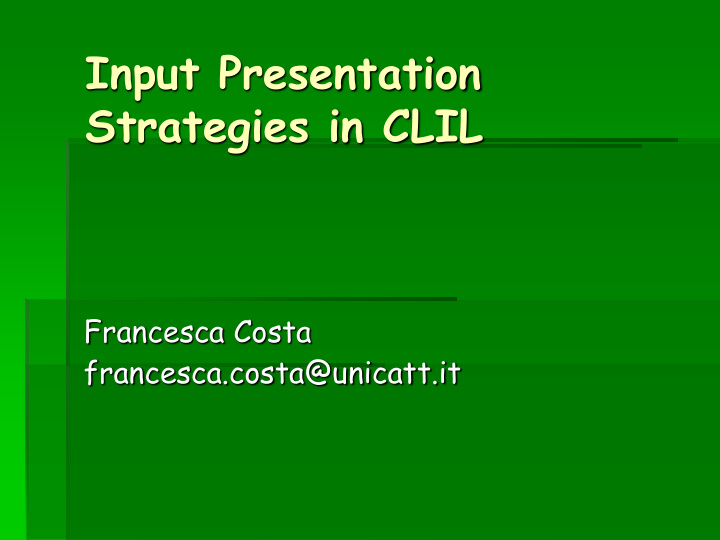



Input Presentation Strategies in CLIL Francesca Costa francesca.costa@unicatt.it
What will I talk about? • Terminology • Studies on CLIL • Research Project • Defamiliarising Input Strategies • What is Our Role? Francesca Costa
WHAT DO I CALL IT? Francesca Costa
Definition Content and Language Integrated Learning (CLIL) involves teaching a curricular subject through the medium of a language other than that normally used. The subject can be entirely unrelated to language learning, such as history lessons being taught in English in a school in Spain. CLIL is taking place and has been found to be effective in all sectors of education from primary through to adult and higher education. Its success has been growing over the past 10 years and continues to do so. (http://ec.europa.eu/education/languages/language- teaching/doc236_en.htm) Francesca Costa
Documents White Paper 1995 Legge sull’Autonomia 440/97 Art. DPR 275 8/3/99 Progetto Lingue 2000 Action Plan per 2004-2006 della Commissione Europea Legge 53 del 2003 (Moratti) D.M. 61/2003 Articolo 2 D.M. 69 del 28/8/2003 Decreto Legislativo 59 (febbraio 2004) C.M. 29 del 5/3/2004 Linee Guida del Programma Leonardo da Vinci 2004 Legge Gelmini Francesca Costa
CLIL Advantages Increased motivation (Wolff, 2007; Coyle, Hood and Marsh, 2010) Improvement in language skills (Brinton and Snow, 1990; Lyster, 2007; Mehisto, Marsh and Frigols, 2008; Wiesemes, 2009; Navés, 2011) Deeper processing of the subject matter or both (Marsh and Langé, 1999, 2000; Masih, 1999; Pavesi, Bertocchi, Hofmannová and Kazianka, 2001; Coonan, 2002; Langé, 2002; Maggi, Mariotti and Pavesi, 2002; Marsh, 2002; Maljers, Marsh and Wolff, 2007; Van de Craen, Ceuleers and Mondt, 2007; Dafouz and Guerrini, 2009; Coyle, Hood and Marsh, 2010; Nordmeyer and Baruhn, 2010) Economic (Mehisto and Marsh, 2011) Francesca Costa
Success Factors According to Navés (2009): respect and support for learner's L1 and home culture hiring of multilingual and bilingual teachers presence of long-term teaching staff parental involvement joint effort of all parties involved high teacher profile and training high expectations assessment and use of right materials. Francesca Costa
Research Questions What input presentation strategies are present in CLIL lessons? Which are perceived as the most useful ones? Francesca Costa
Instrument and Sample Questionnaire on a Likert scale ( very helpful, helpful, a bit helpful, not helpful at all ) 134 + 126 students 18 hours of trascriptions Francesca Costa
INPUT PRESENTATION STRATEGIES (Coonan, 2002) Repetitions Examples Summaries Definitions Synonyms Questions Intonation Francesca Costa
+ Defamiliarising Strategies Use of Humour Use of Focus on Form (lexical, grammatical, phonological) Use of Metaphors Use of Codeswitching (as a form of fof) Francesca Costa
Tips All strategies are considered useful by the students These results could lead to hypothesise a new role for language teachers in terms of linguistic support for CLIL content teachers Francesca Costa
THANK YOU! Francesca Costa
Recommend
More recommend